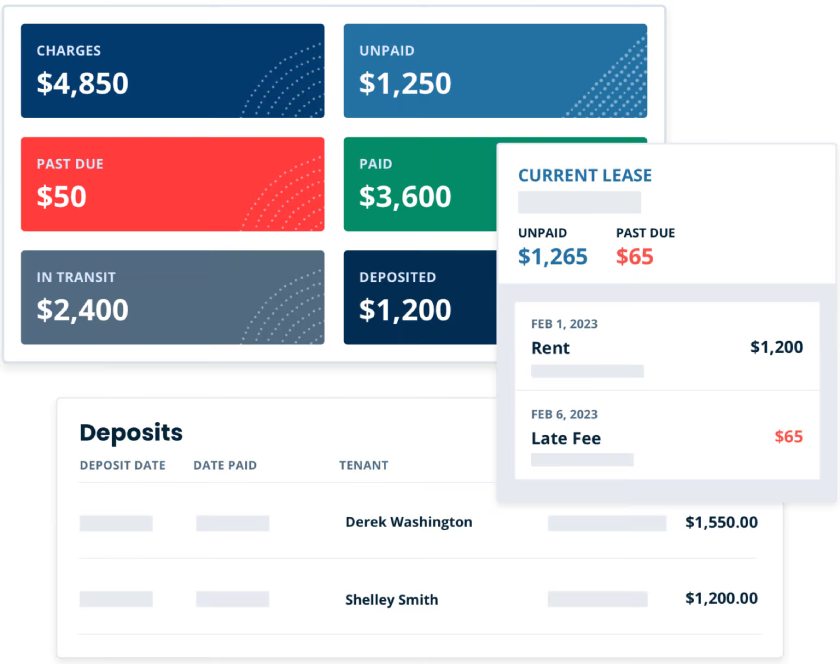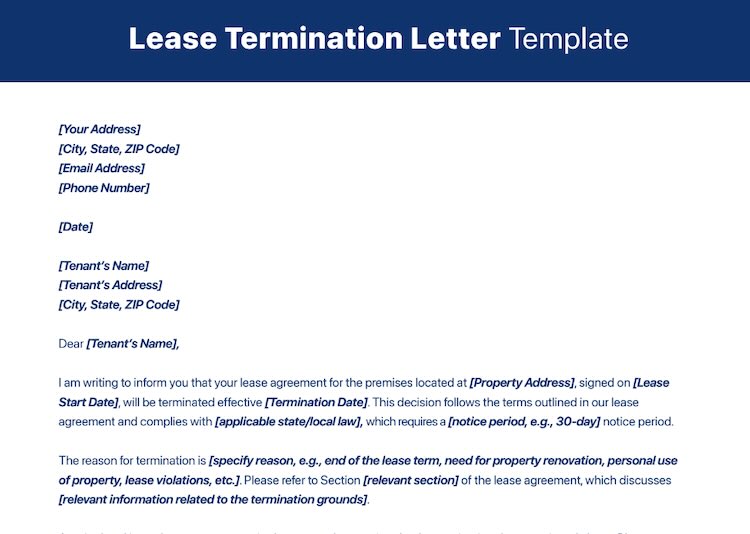Terminating a lease agreement holds substantial implications for landlords and tenants, entailing legal and personal considerations. Landlords must understand the rights and responsibilities and have an effective lease termination letter to reduce potential conflicts and facilitate a seamless transition between tenant and landlord. I’ve provided a customizable lease termination letter template for download below. Follow the step-by-step process on how to personalize a lease termination letter to fit your needs.
What Is a Lease Termination Letter?
A lease termination letter is a formal notification issued by either the landlord or the tenant indicating the end of the current lease agreement. It serves multiple functions:
- Provides a record of the intent to end the lease
- Outlines the reasons for termination
- Specifies the date by which the tenant needs to vacate the property

An essential document for maintaining communication and upholding legal obligations
Elements of a Lease Termination Letter
The termination of lease agreement letter must be clear and comprehensive, containing all necessary elements to ensure it is legally sound and unambiguous. Here are the essential components that should be included:
- Landlord’s name and contact information: Indicate the landlord’s or property management company’s full name and contact details.
- Date: Indicate the date when the lease termination letter to the tenant is written.
- Tenant’s name and address: Start with the tenant’s full name and current address as listed in the lease.
- Reference to the lease: Mention the date the lease started and any other relevant details from the original lease agreement.
- Termination date: Clearly state the effective date of lease termination.
- Reason for termination: Provide the reason for termination to clarify the situation (e.g., end of lease term, lease violations).
- Instructions for vacating the premises: Details on how and when the tenant should leave the property.
- State law and lease compliance: Cite state laws or lease clauses supporting the termination notice.
- Forwarding address for security deposit: Provide information on where to send the remaining security deposit.
- Signature: The landlord or their representative should sign the tenant lease termination letter.
How to Write a Tenant Lease Termination Letter
When ending a lease, whether because of expiration, violations, or other reasons, writing a clear and compliant termination of lease notice is crucial for both landlords and tenants. Use this guide to craft an effective lease termination letter that adheres to legal standards and communicates the necessary information transparently. From verifying legal requirements to drafting the final signature, each step is designed to ensure that the process of ending a lease is conducted smoothly and professionally.
Step 1: Verify the Lease & Legal Requirements
Before drafting your termination of lease letter, thoroughly review the lease agreement to identify any specific clauses related to termination, such as notice periods or conditions. Additionally, familiarize yourself with local and state landlord-tenant laws that govern lease terminations to ensure compliance. This initial step prevents potential legal issues and clarifies the obligations and rights outlined in the lease.
Here is an example:
Step 2: Draft the Opening Statement
The opening statement of your end-of-lease letter should communicate its purpose in a respectful and direct manner. Begin by formally addressing the tenant using their full name and include the date the letter is written to avoid any confusion regarding timelines. This approach sets a professional tone for the communication and plainly outlines the intent of the notice.
Here is an example of a good opening statement:
“Dear [Tenant’s Name],
This letter serves as formal notification that your lease agreement dated [Start Date] for the premises located at [Property Address] will be terminated as of [Termination Date].”
Step 3: Specify the Reason for Termination
Providing a clear reason in your notice of lease termination fulfills legal and ethical standards and helps maintain a transparent relationship with your tenant. Whether the termination is due to lease violations, the end of the lease term, or other reasons, specifying this prevents misunderstandings and potential disputes. If applicable, refer to the lease sections that support your decision to terminate the lease.
You can state the reason by mirroring the example below:
One of the most common reasons why landlords terminate leases is due to bad tenants who refuse to comply with set agreements. To avoid such tenants, it is crucial to screen your tenants thoroughly. Taking the time to screen tenants can save you the trouble of dealing with a bad tenant in the future and going through long eviction processes.

Track and set reminders for rental payments (Source: TurboTenant)
TurboTenant is one of the best tenant screening services for landlords. It provides robust features like rental listing syndication, online rent collection, lead management, and expense tracking to help you screen tenants thoroughly and find the best ones for your properties. The intuitive design of TurboTenant’s tools and resources consistently enhances usability and efficiency for landlords and tenants, making it a go-to solution for effective property management.
Step 4: Detail the Procedure for Vacating
Clearly outline what the tenant needs to do before vacating the property on your tenant lease termination letter. This includes the condition in which the property should be left, the exact date the property should be vacated, and any other lease obligations the tenant must fulfill. Providing this detailed information in your rental termination letter helps ensure that the process goes smoothly and reduces the likelihood of disputes over property conditions or deposit refunds.
Here’s an example of a procedure for vacating:
Also, provide the tenant with clear instructions on how to return the keys to the property. This should include how and where to drop off the keys and the deadline for returning them. Doing so can avoid any disputes over lost or missing keys and ensure a smooth transition between tenants.

Step 5: Outline the Security Deposit Process
In your lease termination notice, inform the tenant of the process for returning their security deposit. Specify the timeline for the return, any conditions under which deductions will be made, and the payment method. This clarity is essential for both parties and helps expedite the closure of the agreement without unnecessary complications or legal challenges.
You can use this example to outline the process for returning the security deposit:
Step 6: Closing Statement
Conclude your lease termination letter with a cordial and open-ended invitation for the tenant to discuss any questions or concerns. This fosters good relations and may ease the transition for both parties. Providing your direct contact information makes it easy for the tenant to reach out, potentially preventing miscommunications and helping resolve any issues promptly.
Here’s a good example of an effective and concise closing statement:
Step 7: Signature
Put a formal closure and your signature at the end of the notice of termination of the lease. This adds a personal touch and validates the letter as an official document. If applicable, include your printed name and title to reinforce the professionalism of the communication.
You can mirror this example of a formal closure and signature:
“Sincerely,
[Your Name]
[Your Position]”
Legal Considerations Surrounding Lease Termination
Landlords have to deal with complex legal considerations when terminating a lease. It is important to handle the process properly while respecting the tenant’s rights and fulfilling the landlord’s obligations under the law. Here are some key legal considerations that you need to keep in mind while terminating a lease:
- Adherence to lease agreements: Landlords must strictly follow the terms outlined in the lease agreement, especially those regarding notice periods and conditions for termination. Any deviation can result in disputes and potential liabilities.
- Notice requirements: Laws typically require landlords to give a specific notice period before the lease ends (often 30 to 60 days).
- Reasons for termination: Some jurisdictions require a valid cause for termination, such as nonpayment of rent, lease violations, or the landlord’s need to occupy the property.
- Protected classes: Laws may offer additional protections for certain groups, such as the elderly or disabled, influencing how leases can be legally terminated.
- Security deposits: State laws usually dictate the timeframe for returning security deposits, commonly 30 to 60 days after lease termination. If deductions are made for damages beyond normal wear and tear or unpaid rent, you must provide an itemized statement outlining these deductions.
- Eviction process: If tenants do not vacate voluntarily after a lease is terminated, landlords may need to initiate an eviction, which involves clearly stating legally valid reasons for eviction, filing an eviction notice, and attending a court hearing if the tenant contests the eviction.

To avoid legal repercussions, landlords should ensure they understand and comply with both the specific terms of their lease agreements and the broader landlord-tenant laws applicable in their jurisdiction. We recommend consulting with a real estate attorney to ensure compliance with local laws and to prevent potential legal challenges.
Frequently Asked Questions (FAQs)
Yes, you can draft your own termination letter as long as it incorporates all necessary information, such as the reason for termination, the date of termination, and any specific terms outlined in the lease agreement. However, ensure the letter adheres to local and state laws regarding lease terminations to avoid legal issues.
Avoid using any language that could be construed as discriminatory or inflammatory. Additionally, refrain from making false accusations or providing incorrect information about the reason for termination. Maintaining professionalism and clarity in the letter is important to prevent misunderstandings or disputes.
Yes, sending a lease termination letter via email is generally acceptable, especially if it’s a convenient and efficient means of communication for both parties. However, check whether the lease agreement or local laws specify any requirements regarding the delivery method for termination notices. Furthermore, ensure that the email contains all necessary information, including your signature, to be considered valid.
Bottom Line
Writing a lease termination letter is a crucial skill for landlords. It ensures you respect legal boundaries and maintain a professional relationship with tenants. By following the structure, guidelines, and example of a lease termination letter provided in this guide, you can communicate lease terminations effectively. This approach safeguards your real estate investment property and rights while giving clear instructions and expectations to your tenants.
